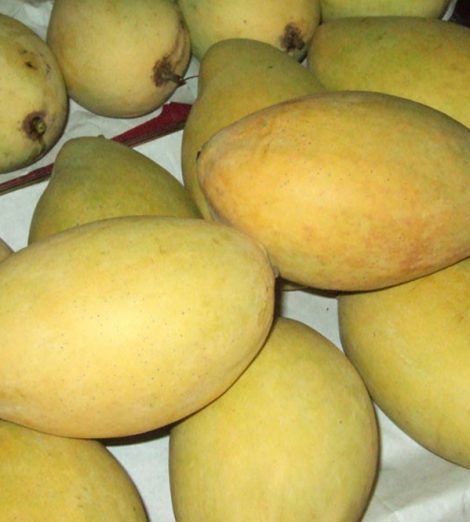Mango fruit is one of the most popular, nutritionally rich fruits with unique flavor, fragrance, taste, and heath promoting qualities making it a common ingredient in new functional foods often labeled “super fruits.”
Mango is one of the delicious seasonal fruits grow in the tropics. The tree is believed to be originating in the sub-Himalayan plains of Indian subcontinent. Botanically, this exotic fruit belongs within the family of Anacardiaceae, a family that also includes numerous species of tropical-fruiting trees in the flowering plants such as cashew, pistachio,…etc.
Mango is a tropical tree cultivated in many regions of India and now distributed wide across the world in many continents. Usually, fruits grow at the end of a long, string like stem, with sometimes more than one fruit to a stem.
Each fruit measures 5 to 15 cms in length and about 4 to 10 cms in width, and has typical “mango” shape, or sometimes oval or round. Its weight ranges from 150 gm to around 750 gm. Outer skin is smooth and is green in un-ripe mangoes but turns into golden yellow, bright, yellow or orange-red when ripen depending upon the cultivar. Fresh mango season lasts from April until August.
Mango comes in different shapes and sizes depending upon cultivar types. Internally, the flesh is juicy, orange-yellow in color with numerous soft fibrils radiating from its centrally placed flat, oval-shaped stone (enveloping a single large kidney-shaped seed). Its flavor is pleasant and rich, and tastes sweet with mild tartness. A high-quality mango fruit should feature no or very less fiber content and minimal sour taste. Mango seed (stone) may either has a single embryo, or sometimes polyembryonic.
mango fruit is one of the most popular, nutritionally rich fruits with unique flavor, fragrance, taste, and heath promoting qualities making it a common ingredient in new functional foods often labeled “super fruits.”
Mango is one of the delicious seasonal fruits grow in the tropics. The tree is believed to be originating in the sub-Himalayan plains of Indian subcontinent. Botanically, this exotic fruit belongs within the family of Anacardiaceae, a family that also includes numerous species of tropical-fruiting trees in the flowering plants such as cashew, pistachio,…etc.
Mango is a tropical tree cultivated in many regions of India and now distributed wide across the world in many continents. Usually, fruits grow at the end of a long, string like stem, with sometimes more than one fruit to a stem.
Each fruit measures 5 to 15 cms in length and about 4 to 10 cms in width, and has typical “mango” shape, or sometimes oval or round. Its weight ranges from 150 gm to around 750 gm. Outer skin is smooth and is green in un-ripe mangoes but turns into golden yellow, bright, yellow or orange-red when ripen depending upon the cultivar. Fresh mango season lasts from April until August.
Mango comes in different shapes and sizes depending upon cultivar types. Internally, the flesh is juicy, orange-yellow in color with numerous soft fibrils radiating from its centrally placed flat, oval-shaped stone (enveloping a single large kidney-shaped seed). Its flavor is pleasant and rich, and tastes sweet with mild tartness. A high-quality mango fruit should feature no or very less fiber content and minimal sour taste. Mango seed (stone) may either has a single embryo, or sometimes polyembryonic.












Reviews
There are no reviews yet.